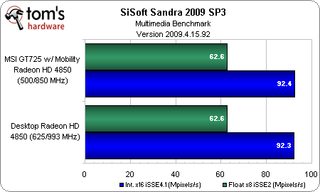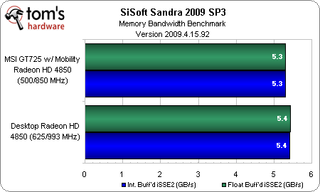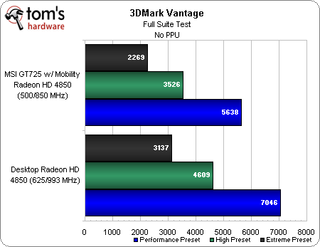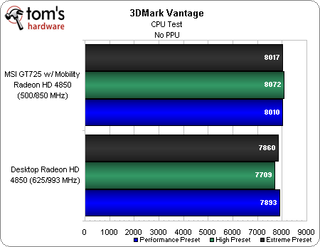Mobile GeForce GTX Graphics: Model Inflation Gone Awry
Angelini: Taking ATI To Task, Too
Throughout this piece, we've focused on Nvidia's naming/architecture issues, which were made most apparent when Thomas started looking at Eurocom’s Panther workstation notebook. This is an Nvidia problem though, not a Eurocom one, so we broke it into a separate editorial.
Just because Nvidia has it wrong here doesn’t mean ATI comes away innocent. Again, this is a game of relativity, and when ATI calls its second-fastest mobile GPU the Mobility Radeon HD 4850, Nvidia sees that its flagship is faster and suddenly becomes vindicated in calling its flagship the GeForce GTX 280M. That's not doing right by the mainstream gamer, but it makes competitive sense.
What we really need are both companies to come clean in naming mobile hardware after desktop-class performance parts and skewing end-user expectations of what their new notebooks will be able to do. In this case, ATI is “less-guilty,” since its Mobility Radeon HD 4850 is actually based on the RV770 architecture driving the desktop lineup. However, the necessary loss in clock speed to fit within a certain thermal envelope is such that what you end up with runs nothing like a Radeon HD 4850.
Putting Numbers To The Claim
In order to best prove our point here, I built up a desktop machine as comparable as possible to the MSI GT725 that Thomas tested in his Eurocom D900F review. It consisted of a Core 2 Quad Q8400S running a 1,066 MHz front side bus and 7.5x multiplier (yielding 2 GHz), 2 GB of DDR2-800 memory, and a reference ATI Radeon HD 4850 running at stock clocks.






A down-clocked Q8400S isn’t the same as a mobile Core 2 Quad Q9000—there’s a 2MB difference in shared L2 cache. So, I ran a handful of synthetics to make sure these platforms were still similar enough to stand up to each other.
In fact, the results come close enough (and indeed favor the mobile solution, if anything, given the larger L2).
Stay on the Cutting Edge
Join the experts who read Tom's Hardware for the inside track on enthusiast PC tech news — and have for over 25 years. We'll send breaking news and in-depth reviews of CPUs, GPUs, AI, maker hardware and more straight to your inbox.


The differences here aren’t as severe as what we just saw comparing a G92-based mobile GeForce GTX 280M to a desktop GTX 280, but they’re certainly notable enough that ATI should perhaps reconsider calling the Mobility Radeon HD 4850 by a name that doesn’t reflect what mainstream buyers have come to expect from reading reviews of desktop-class Radeon HD 4850 cards.
Clarifying Criticism
In discussing with Nvidia about this impending editorial, the company expressed an understanding that enthusiasts might object to its naming convention. But it isn’t the power users we’re worried about. Rather, it’s the mainstream folks who know enough to recognize GeForce GTX 280 or Radeon HD 4850, but not enough to realize that the underlying technology is completely different, or that a loss in clock speed gives the graphics solution different performance attributes.
At this moment in time, Nvidia is clearly the more-guilty vendor, but ATI is not innocent either. We’d implore both companies to reconsider the naming of their respective mobile graphics offerings (and it will, indeed, take both companies cooperating here in order to alter the relativistic nature of competitive placement).
We realize they both have powerful brands in the GeForce and Radeon, but if they’re going to recycle model numbers, do customers a favor and serve up a certain degree of consistency. Otherwise, we all end up with situations like this one, where the desktop and mobile markets are alike in name, but nothing else.
-
tacoslave and here i thought they were going to name it the gts 250m, but 280m? thats just lowReply -
Crashman IzzyCraftProbably not more then 30 mins But that's not the point.Reply
Actually, if you look at the notebook it's in...you could probably cool at least a GTX 275 with same-sized sinks if you had a lower power CPU. -
Sharft6 :o i never noticed this before although I've never had a laptop before. maybe this article could stoke up the the big boys in the gfx department to rethink their naming schemes :)Reply -
apache_lives will these parts crash and burn like every other previous nvidia product released for laptop over the last 2 years?Reply -
Crashman Reply9476634 said:Well, the laptop maker could always try putting in a normal Geforce card...
It would be hard, but when nVidia makes a card using the same specs as the GTS 250...except lower clock speeds...it could at least call the thing a GTS 250M.
Then again, both it an the GTS 250 are actually die-shrunk, underclocked 8800 GTS 512s...with twice the memory. -
falchard I think the die on the GTX 260+ is just too large to shrink down to be cool enough and power hungryless enough to put in a laptop.Reply
Most Popular


